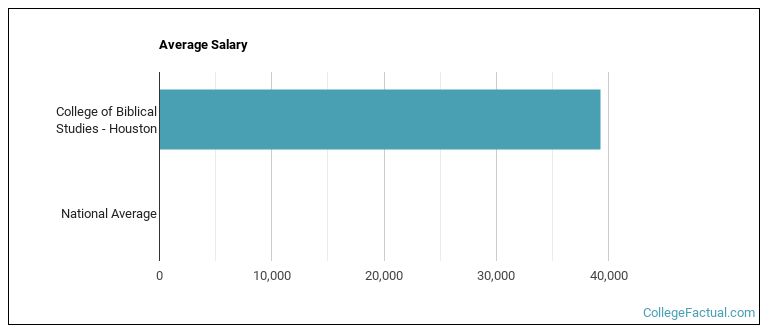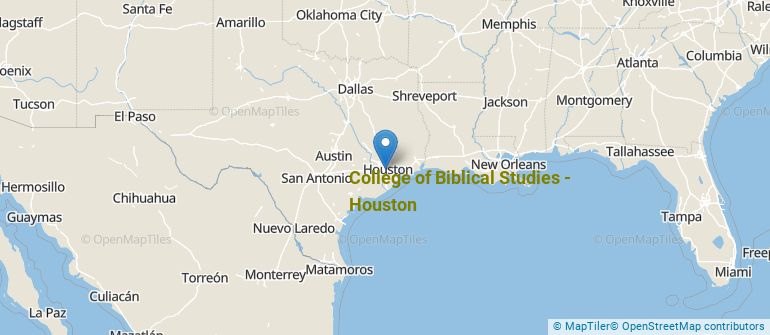 by our College Data Analytics Team
by our College Data Analytics TeamExplore the best ranked schools for the programs you are most interested in.
College of Biblical Studies - Houston was not ranked in College Factual's 2025 Best Overall Colleges report. This could be for a number of reasons, including lack of data.
See all of the rankings for College of Biblical Studies - Houston.
Returning adults and other non-traditional students may appreciate the fact that College of Biblical Studies - Houston has an open admissions policy. This means that you'll only have to submit basic materials, which may include proof that you completed high school or an equivalent program.
The student to faculty ratio is often used to measure the number of teaching resources that a college or university offers its students. The national average for this metric is 15 to 1, but at College of Biblical Studies - Houston it is much better at 12 to 1. That's good news for students who want to interact more on a personal level with their teachers.
In addition to the student to faculty ratio, some people look at what percentage of faculty members are full-time as a sign of how much time professors will be able to spend with their students. This is because part-time teachers may not be be on campus as much as their full-time counterparts.
The full-time faculty percentage at College of Biblical Studies - Houston is 44%. This is comparable to the national average of 47%.
The freshmen retention rate is a sign of how many full-time students like a college or university well enough to come back for their sophomore year. At College of Biblical Studies - Houston this rate is 57%, which is a bit lower than the national average of 68%.
During the 2017-2018 academic year, there were 431 undergraduates at College of Biblical Studies - Houston with 119 being full-time and 312 being part-time.
The net price is calculated by adding tuition, room, board and other costs and subtracting financial aid.Note that the net price is typically less than the published for a school. For more information on the sticker price of College of Biblical Studies - Houston, see our tuition and fees and room and board pages.
Almost 66% of college students who graduated with the class of 2018 took out student loans, but that percentage varies from school to school. At College of Biblical Studies - Houston, approximately 8% of students took out student loans averaging $4,701 a year. That adds up to $18,804 over four years for those students.
Get more details about paying for College of Biblical Studies - Houston.

See which majors at College of Biblical Studies - Houston make the most money.
Get more details about the location of College of Biblical Studies - Houston.

Contact details for College of Biblical Studies - Houston are given below.
| Contact Details | |
|---|---|
| Address: | 7000 Regency Square Blvd., Houston, TX 77036-3211 |
| Phone: | 713-785-5995 |
| Website: | https://cbshouston.edu/ |
| Facebook: | https://www.facebook.com/BiblicalStudies?ref=hl |
| Twitter: | https://twitter.com/CBSHouston |
| Most Popular Majors | Bachelor’s Degrees | Average Salary of Graduates |
|---|---|---|
| Biblical Studies | 26 | NA |
| Business Administration & Management | 2 | NA |
Online learning options are becoming more and more popular at American colleges and universities. Online classes are great for students who have busy schedules or for those who just want to study on their own time.
In 2022-2023, 205 students took at least one online class at College of Biblical Studies - Houston. This is a decrease from the 418 students who took online classes the previous year.
| Year | Took at Least One Online Class | Took All Classes Online |
|---|---|---|
| 2022-2023 | 205 | 205 |
| 2021-2022 | 418 | 418 |
| 2020-2021 | 431 | 43 |
| 2018-2019 | 288 | 107 |
Learn more about online learning at College of Biblical Studies - Houston.
Footnotes
*The racial-ethnic minorities count is calculated by taking the total number of students and subtracting white students, international students, and students whose race/ethnicity was unknown. This number is then divided by the total number of students at the school to obtain the racial-ethnic minorities percentage.
References
More about our data sources and methodologies.